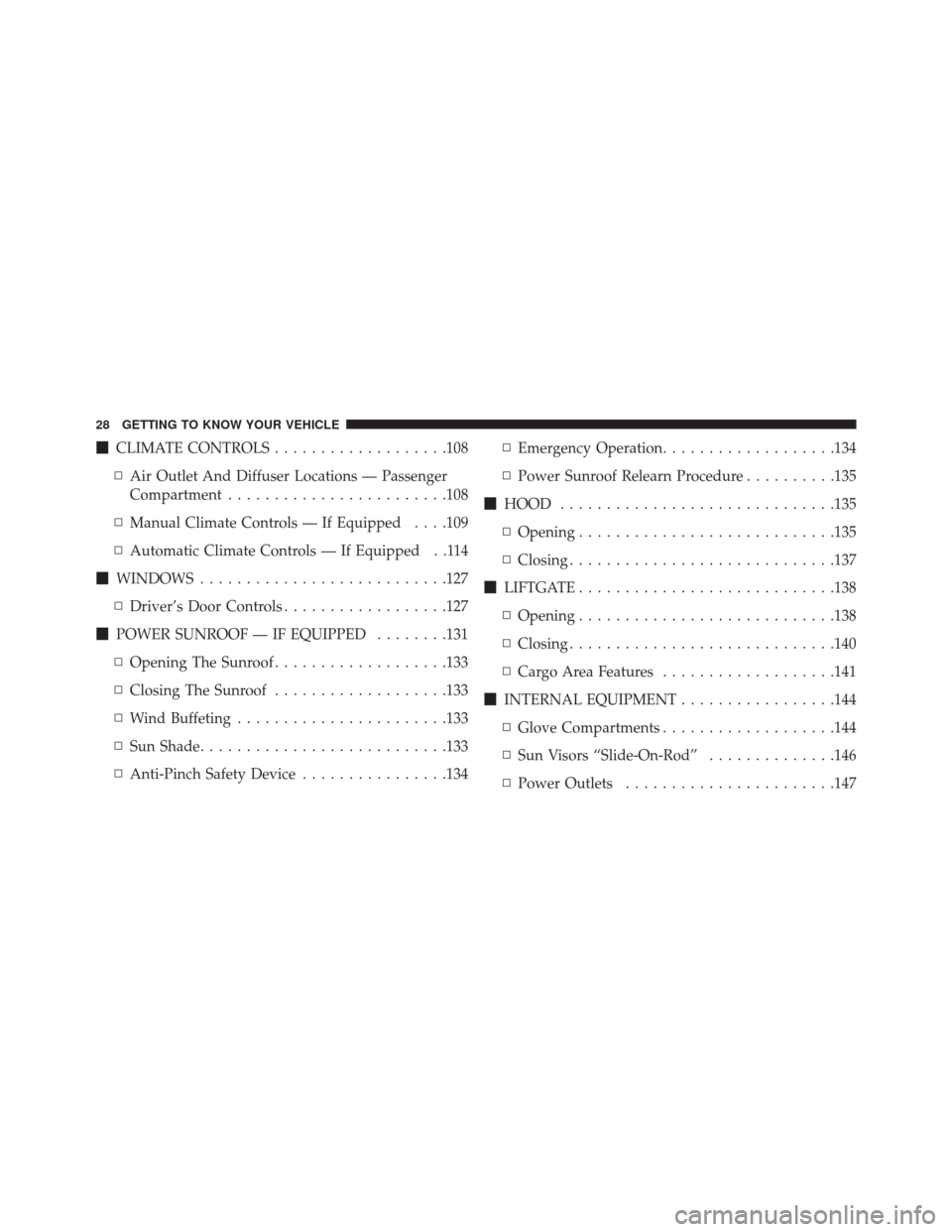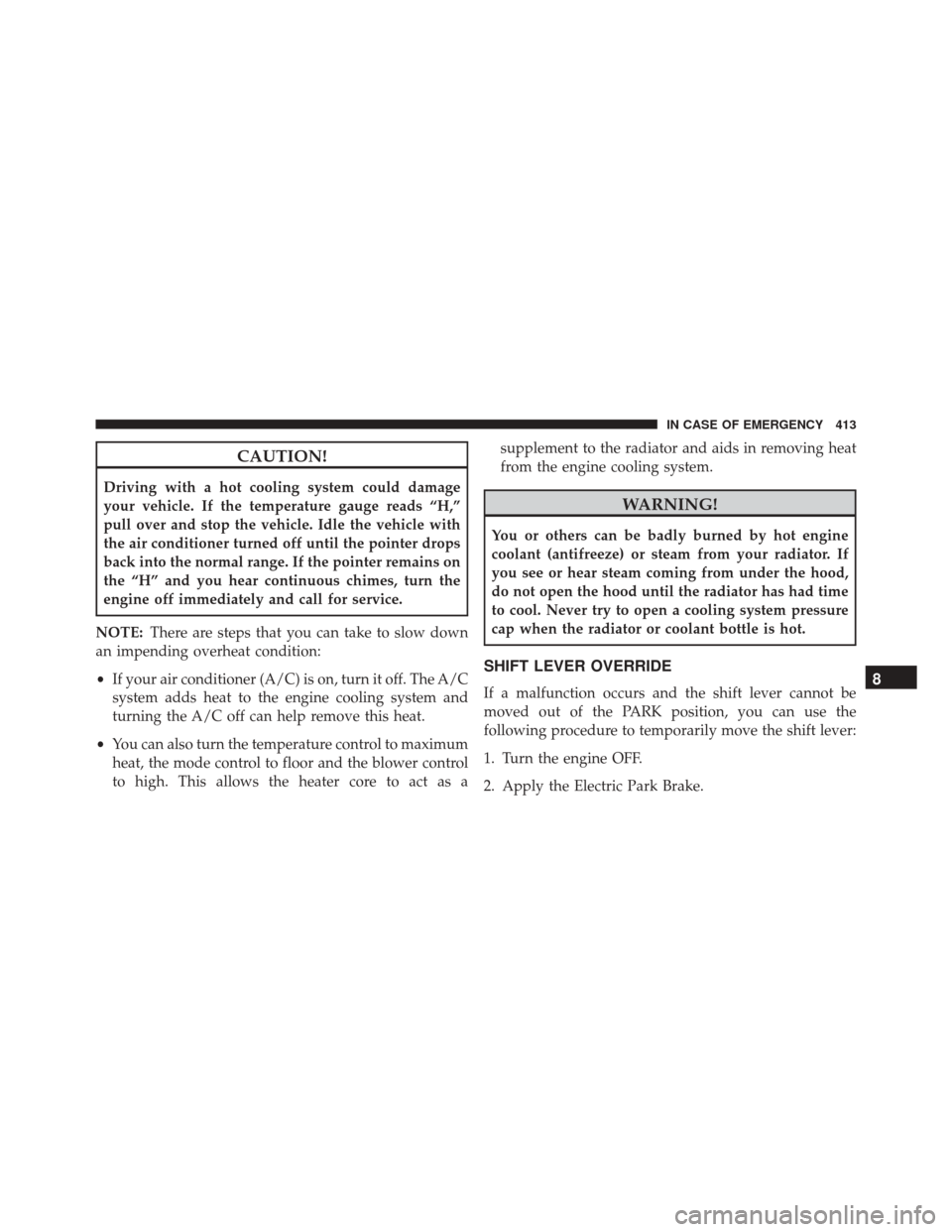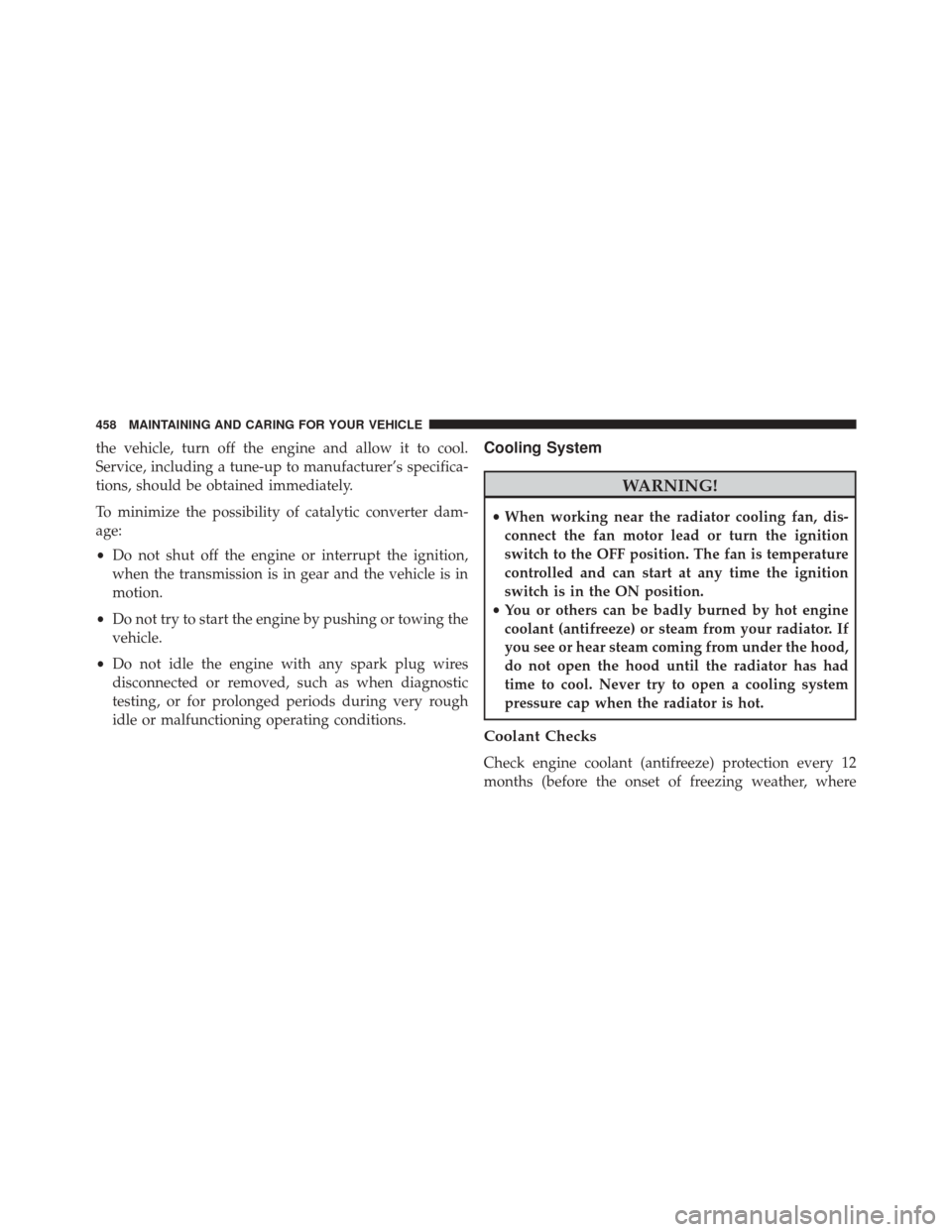Page 30 of 587

�CLIMATE CONTROLS ...................108
▫ Air Outlet And Diffuser Locations — Passenger
Compartment ....................... .108
▫ Manual Climate Controls — If Equipped . . . .109
▫ Automatic Climate Controls — If Equipped . .114
� WINDOWS .......................... .127
▫ Driver’s Door Controls ..................127
� POWER SUNROOF — IF EQUIPPED ........131
▫ Opening The Sunroof ...................133
▫ Closing The Sunroof ...................133
▫ Wind Buffeting ...................... .133
▫ Sun Shade .......................... .133
▫ Anti-Pinch Safety Device ................134 ▫
Emergency Operation ...................134
▫ Power Sunroof Relearn Procedure ..........135
� HOOD ............................. .135
▫ Opening ........................... .135
▫ Closing ............................ .137
� LIFTGATE ........................... .138
▫ Opening ........................... .138
▫ Closing ............................ .140
▫ Cargo Area Features ...................141
� INTERNAL EQUIPMENT .................144
▫ Glove Compartments ...................144
▫ Sun Visors “Slide-On-Rod” ..............146
▫ Power Outlets ...................... .147
28 GETTING TO KNOW YOUR VEHICLE
Page 137 of 587

CAUTION!
•When refitting sunroof, be careful to avoid fingers,
scarves, ties and items of clothing from getting
caught under the panel.
• Do not open the roof in the presence of snow or ice.
There is risk of damage.
Power Sunroof Relearn Procedure
As a result of any abnormal behavior of the roof or as a
result of an emergency operation, and you must relearn
the automatic operation of the sunroof.
Proceed as follows:
1. Push the Open/Close button to move the roof in the fully closed position.
2. Bring the ignition to the STOP/OFF position and wait for at least 10 seconds. 3. Bring the ignition to the position MAR/RUN.
4. Pull the Open/Close button and hold it for at least 10
seconds, after which you should feel the mechanical
stop of the electric motor of the roof.
5. Within 5 seconds, pull to close and hold the Open/ Close button, the roof makes a complete cycle of
opening and closing automatically (to indicate that the
relearn procedure has been successful). If this does not
happen and you need to repeat the procedure from the
beginning.
HOOD
Opening
The hood release lever (to open the primary latch) and
safety latch (to open the secondary latch) must be re-
leased to open the hood.
4
GETTING TO KNOW YOUR VEHICLE 135
Page 140 of 587
CAUTION!
To prevent possible damage, do not slam the hood to
close it. Lower the hood until it is open approxi-
mately 6 inches (15 cm), and then drop it. This should
secure both latches. Never drive your vehicle unless
the hood is fully closed, with both latches engaged.
WARNING!
Be sure the hood is fully latched before driving your
vehicle. If the hood is not fully latched, it could open
when the vehicle is in motion and block your vision.
Failure to follow this warning could result in serious
injury or death.
LIFTGATE
The Liftgate release function is disabled when the vehicle
is in motion.
Opening
Opening From Outside
To unlock the Liftgate from the outside, squeeze the
Electronic Liftgate Release and pull the Liftgate open
with one fluid motion.
When opening the door, the turn signal lights will flash
138 GETTING TO KNOW YOUR VEHICLE
Page 189 of 587
(if at idle). If the charging system light remains on, it
means that the vehicle is experiencing a problem with
the charging system.
•What To Do
Have your vehicle serviced immediately. See an au-
thorized dealer.
Door Ajar •What Does It Mean
This light will illuminate to indicate that
one or more doors may be ajar. With the
doors open and the vehicle in motion, a
chime will sound.
What To Do
Properly close the door(s). Hood Open Warning Light
•What Does It Mean
The light will illuminate when the engine
hood is not completely closed. With the
hood open and the vehicle in motion, a
chime will sound.
• What To Do
Properly close the hood.
Liftgate Open Warning Light •What Does It Mean
This light will illuminate when the liftgate
is open. With the tailgate open and the
vehicle in motion, a chime will sound.
• What To Do
Properly close the liftgate.
5
GETTING TO KNOW YOUR INSTRUMENT CLUSTER 187
Page 409 of 587
NOTE:The positive battery post is covered with a
protective cap. Lift up on the cap to gain access to the
positive battery post.
WARNING!
• Take care to avoid the radiator cooling fan when-
ever the hood is raised. It can start anytime the
ignition switch is ON. You can be injured by
moving fan blades.
• Remove any metal jewelry such as rings, watch
bands and bracelets that could make an inadvertent
electrical contact. You could be seriously injured.
• Batteries contain sulfuric acid that can burn your
skin or eyes and generate hydrogen gas which is
flammable and explosive. Keep open flames or
sparks away from the battery.
Battery Posts
1 — Positive Battery Post
2 — Negative Battery Post8
IN CASE OF EMERGENCY 407
Page 415 of 587

CAUTION!
Driving with a hot cooling system could damage
your vehicle. If the temperature gauge reads “H,”
pull over and stop the vehicle. Idle the vehicle with
the air conditioner turned off until the pointer drops
back into the normal range. If the pointer remains on
the “H” and you hear continuous chimes, turn the
engine off immediately and call for service.
NOTE: There are steps that you can take to slow down
an impending overheat condition:
• If your air conditioner (A/C) is on, turn it off. The A/C
system adds heat to the engine cooling system and
turning the A/C off can help remove this heat.
• You can also turn the temperature control to maximum
heat, the mode control to floor and the blower control
to high. This allows the heater core to act as a supplement to the radiator and aids in removing heat
from the engine cooling system.
WARNING!
You or others can be badly burned by hot engine
coolant (antifreeze) or steam from your radiator. If
you see or hear steam coming from under the hood,
do not open the hood until the radiator has had time
to cool. Never try to open a cooling system pressure
cap when the radiator or coolant bottle is hot.
SHIFT LEVER OVERRIDE
If a malfunction occurs and the shift lever cannot be
moved out of the PARK position, you can use the
following procedure to temporarily move the shift lever:
1. Turn the engine OFF.
2. Apply the Electric Park Brake.8
IN CASE OF EMERGENCY 413
Page 460 of 587

the vehicle, turn off the engine and allow it to cool.
Service, including a tune-up to manufacturer’s specifica-
tions, should be obtained immediately.
To minimize the possibility of catalytic converter dam-
age:
•Do not shut off the engine or interrupt the ignition,
when the transmission is in gear and the vehicle is in
motion.
• Do not try to start the engine by pushing or towing the
vehicle.
• Do not idle the engine with any spark plug wires
disconnected or removed, such as when diagnostic
testing, or for prolonged periods during very rough
idle or malfunctioning operating conditions.Cooling System
WARNING!
• When working near the radiator cooling fan, dis-
connect the fan motor lead or turn the ignition
switch to the OFF position. The fan is temperature
controlled and can start at any time the ignition
switch is in the ON position.
• You or others can be badly burned by hot engine
coolant (antifreeze) or steam from your radiator. If
you see or hear steam coming from under the hood,
do not open the hood until the radiator has had
time to cool. Never try to open a cooling system
pressure cap when the radiator is hot.
Coolant Checks
Check engine coolant (antifreeze) protection every 12
months (before the onset of freezing weather, where
458 MAINTAINING AND CARING FOR YOUR VEHICLE